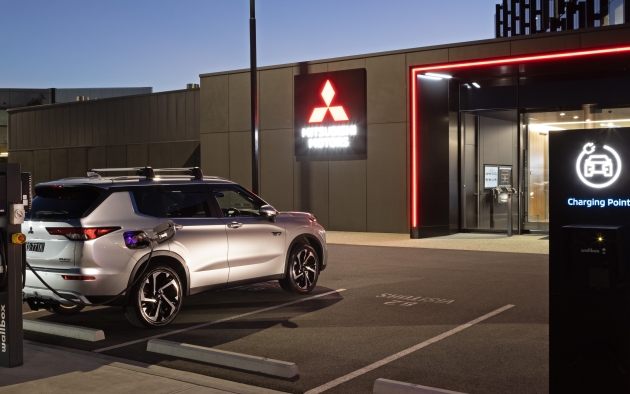
Mitsubishi Motors Australia Limited (MMAL) confirm its bi-directional EV infrastructure has been green lit for grid exports by SA Power Networks (SAPN).
This milestone marks the first approved Australian deployment of vehicle-to-grid (V2G) bi-directional technology by an automotive OEM – a joint effort between MMAL and Australian EV charging provider Jet Charge.
“Since we first announced our head office bi-directional EV infrastructure intentions, MMAL and Jet Charge have been in ongoing consultation with SAPN,” says MMAL’s e-mobility manager Tim Clarke.
“The technology is rapidly emerging, so as SAPN’s operational needs evolved, we worked closely to adapt the installation to ensure grid export requirements were met.”
MMAL hosted SAPN at its Adelaide headquarters as the state’s energy authority held ‘witness testing’ of its Jet Charge-supplied and installed bi-directional hardware and grid protection systems.
A Mitsubishi Outlander plug-in hybrid EV (PHEV) was connected to one of the two Wallbox Quasar 1 bi-directional chargers.
Through its Chademo port, the Outlander PHEV was able to safely export electrical energy stored in its 20kWh lithium-ion on-board drive battery into the state’s power grid.
“Under the approval, MMAL is now unconditionally able to export power from its PHEVs into the grid,” says Clarke.
“This achievement further underscores the wide range of ability our Outlander and Eclipse Cross PHEVs offer.”
MMAL has a fixed 5kW export limit per charger.
The Quasar 1 charger’s ultimate capacity is 7kW which could be realised under a ‘dynamic’ export limit in future, says MMAL.
“Mitsubishi PHEVs are fantastic family vehicles that are perfectly suited to short range EV commuting, with zero tailpipe emissions, backed by range-extending petrol-electric hybrid drive to overcome today’s EV infrastructure limitations,” says Clarke.
“With flexible charging options ranging from the simple domestic socket through to DC fast charging, owners can choose to charge when and where it suits, to minimise cost and maximise convenience,” he says.
“As Australia’s V2G landscape continues to mature and access to bi-directional hardware increases, Mitsubishi PHEV owners are well positioned to benefit. They will be able to export from their PHEV to the grid or home, reinforcing PHEV’s versatility, while enhancing renewable energy deployment and reducing CO2 emissions across transport and in the grid.”
Compatible bi-directional chargers are sold separately to Mitsubishi PHEVs.
Jet Charge chief executive Tim Washington says bi-directional charging will fundamentally change how transport and energy is viewed.
“It will make our vehicles an even bigger part of our everyday lives, powering how we move and how we live.”
Bi-directional charging is an emerging technology that allows two-way sharing of stored energy from an EV’s on-board drive battery to an external energy consumer, via a compatible bi-directional charger.
This technology enables energy sharing applications such as vehicle-to-grid (V2G) and vehicle-to-home (V2H).
A bi-directional charger works similarly to a conventional DC charger, converting AC electricity from the grid to the DC electricity required by EV batteries, but it is also capable of converting this electricity back from DC to AC. As a result, the stored energy can be drawn from the vehicle’s battery and supplied externally.








